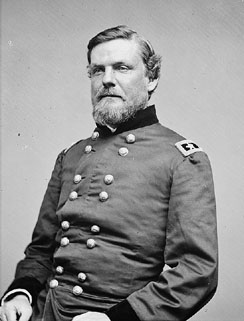| John Newton  Born: 24-Aug-1823 Born: 24-Aug-1823
Birthplace: Norfolk, VA
Died: 1-May-1895
Location of death: New York City
Cause of death: unspecified
Gender: Male
Religion: Roman Catholic
Race or Ethnicity: White
Sexual orientation: Straight
Occupation: Military Nationality: United States
Executive summary: Union Army General and engineer Military service: Union Army (1842-86) American general and engineer, born in Norfolk, Virginia, on the 24th of August 1823, and graduated second in his class at the U.S. Military Academy in 1842. From 1842 to 1861 he was engaged in the construction of coast defenses and the improvement of waterways; he was assistant professor of engineering in the Military Academy from 1843 to 1846, became a captain in 1856, and took part as chief engineer in the Utah expedition of 1857-58. He served as an engineer in the Virginian campaign of 1861, and was promoted brigadier-general, U.S.V., in September. He especially distinguished himself in the Seven Days' battle and at Antietam, and after the battle of Fredericksburg was made major-general, U.S.V. In the Chancellorsville campaign Newton took part in the storming of Marye's Heights at Fredericksburg, on the 3rd of May 1863, and at the battle of Gettysburg he was for a time in command of the 1st corps. He had already received the brevet of lieutenant-colonel for his services at Antietam, and he now became brevet colonel for his services at Gettysburg.
Later he was transferred to William T. Sherman's army, and as a division commander under General Oliver O. Howard took part in the Atlanta campaign. For gallant conduct at Peach Tree Creek he was made brevet brigadier-general, and at the close of the war was made brevet major-general, U.S.A. Returning to regular engineering duty after the war, he was stationed at New York from 1866 to 1884. His most important work there was the improvement of the Hudson river, and especially the removal of the obstructions to shipping in the dangerous entrance to the East river from Long Island Sound, known as Hell Gate. Under two of the largest obstructions -- Hallet's Point and Flood Rock, with a surface of three acres and nine acres respectively -- shafts were sunk from the shore, and tunnels were bored in every direction. In these tunnels thousands of pounds of explosives were placed, and the rocks were blown into fragments. In March 1884 he became Chief of Engineers, with the rank of brigadier-general, and held this position until his retirement from the army, at his own request, in August 1886. In 1887-88 he was commissioner of public works in New York City, and from 1888 until his death, on the 1st of May 1895, he was president of the Panama railway.
Father: Thomas Newton (US general)
Mother: Margaret Jordan
Wife: Anna M. Starr (m. 1848)
University: US Military Academy, West Point (1842)
Professor: Engineering, US Military Academy, West Point (1843-46)
Converted to Catholicism
Do you know something we don't?
Submit a correction or make a comment about this profile
Copyright ©2019 Soylent Communications
|